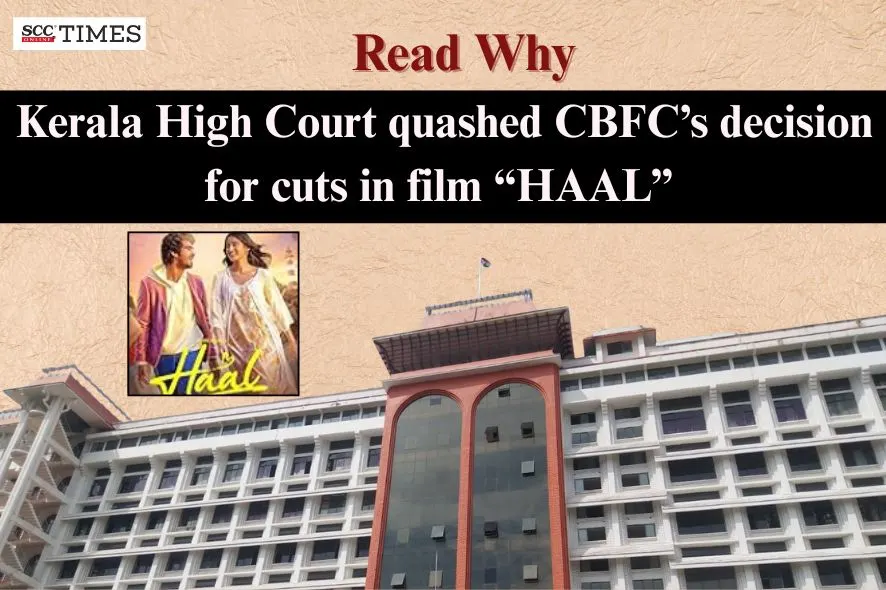Kerala High Court: The present writ petition was filed by the producer and the director (‘petitioners’) of the upcoming film “HAAL”, as they were aggrieved by the decision of the Central Board of Film Certification (‘CBFC’), as it acted upon the recommendations of its Revising Committee and granted only restricted permission for exhibition of the film under “A” Category, with excisions and modifications.
A Single Judge Bench of V.G. Arun, J., found the film’s theme to be in tune with the foundational principles enunciated in the Constitution and stated that instead of judging the film as would be done by an ordinary prudent person, CBFC’s focus was on whether the film would ruffle a few oversensitive feathers. The Court opined that it was beyond comprehension as to how the theme can be termed as misrepresentation of inter-faith relationships, or portrayal of legitimate warnings from Hindu and Christian leaders, as unfounded and intolerant. The Court thus allowed the writ petition and quashed CBFC’s decision, except excision Nos. 5 and 6.
Background
The film, after completion of its production works, was submitted along with the requisite application for censorship, on CBFC’s official portal. It was examined by CBFC’s Examining Committee and was later forwarded to the Revising Committee. Respondent 2-CBFC’s Regional Officer communicated that the film was not suitable for unrestricted exhibition, and thus, permitted only restricted public exhibition with “A” certificate, subject to certain excisions.
Being aggrieved by the decision, the petitioners sought that CBFC’s decision should be set aside, and Respondents 1 to 4 be directed regarding the framing of fresh guidelines for considering censorship applications including script censoring. Further, they also sought that Respondents 1 to 4 be directed to reconsider the application for issuance of censor certificate and grant the same at the earliest.
Analysis, Law, and Decision
The Court opined that it is true that movies have more impact on society than other media and therefore, a check on overplay is essential. The Court, after viewing the film, stated that it was about the romantic relationship between a Muslim boy and a Christian girl, who face a lot of opposition from their families and respective religious communities against their union. In the end, they succeed in convincing their families that love has no religion, and it is possible for them to follow their individual religious beliefs even after marriage and the same is accepted by the religious leaders of both communities.
The Court referred to Sections 3, 4, 5, 5-A, 5-B(1), and 5-B(2) of the Cinematograph Act, 1952 and opined that the competent authority could certify the films differently and even refuse permission for release, but such power cannot be exercised according to the whims and fancies of the authority. The Court noted that the competent authority in the present case had directed excision of certain portions of film by referring to Sections 2(xii), 2(xviii), and 3(i).
The Court opined that “every societal issue, be they economic policy, social justice or governance, must be viewed through the prism of constitutional values and refracted through the foundational principles of justice, liberty, equality and fraternity along with the fundamental rights enshrined in the Constitution of India.”.
After viewing the film from the perspective of an ordinary person, the Court found the film’s theme to be in tune with the foundational principles enunciated in the Constitution. The Court stated that it was beyond comprehension as to how the theme can be termed as misrepresentation of inter-faith relationships, or portrayal of legitimate warnings from Hindu and Christian leaders, as unfounded and intolerant.
The Court stated that a Christian girl wearing Muslim attire or an interrogation scene at the police station with schoolboys present, could not be termed as indecent or immoral, or capable of inciting violence. Further, the depiction of a character as a Bishop of the Christian community and the dialogues of that person falls well within the artistic freedom guaranteed under Article 19(1)(a).
The Court also stated that instead of judging the film as would be done by an ordinary prudent person, CBFC’s focus was on whether the film would ruffle a few oversensitive feathers. Further, even if the contention that CBFC is involved in the act of balancing the freedom of the movie maker with the reasonable restrictions under Article 19(2) was accepted, still such balancing act cannot be carried out by overlooking the foundational principles of secularism and fraternity which are the bedrock of great democracy.
The Court thus allowed the writ petition and quashed CBFC’s decision, except excision Nos. 5 and 6. Further, it was stated that once the petitioners resubmitted the film after carrying out excision Nos. 5 and 6, CBFC shall examine the film following the prescribed procedure and issue fresh certification, within two weeks of re-submission.
[Juby Thomas v. Union of India, 2025 SCC OnLine Ker 12334, decided on 14-11-2025]
Advocates who appeared in this case:
For the Petitioners: E.S. Saneej, John Vithayathil, Advocates
For the Respondents: Rajagopalan. A., CGC; P. Sreekumar, Sr. Advocate; Mariya Rajan, S. Anil Kumar (Cherthala), Shinu J. Pillai, S. Suja, Ann Mariya John, Felix Samson Varghese, Advocates



